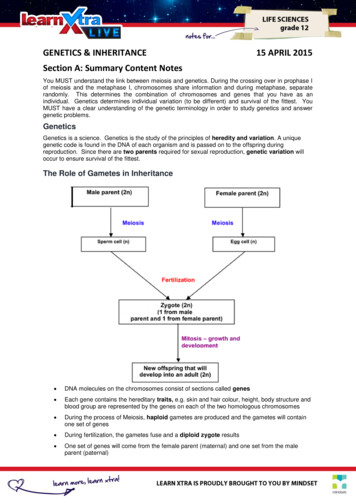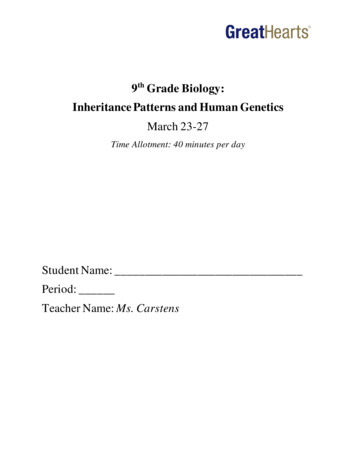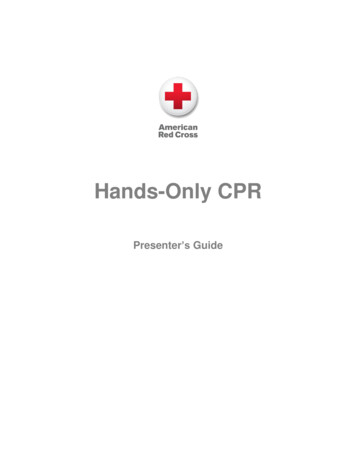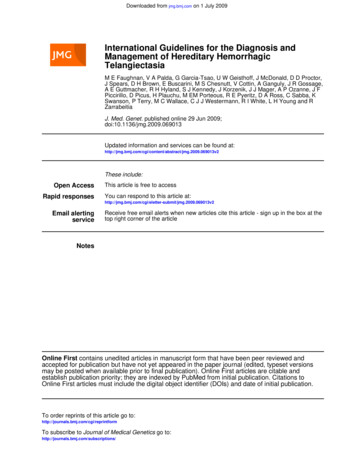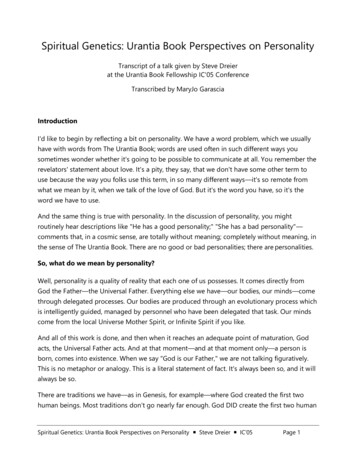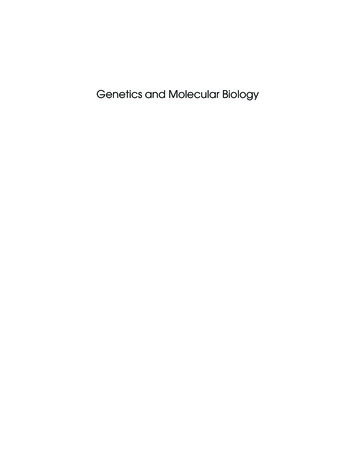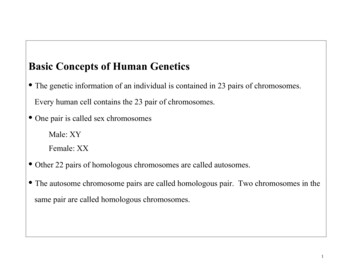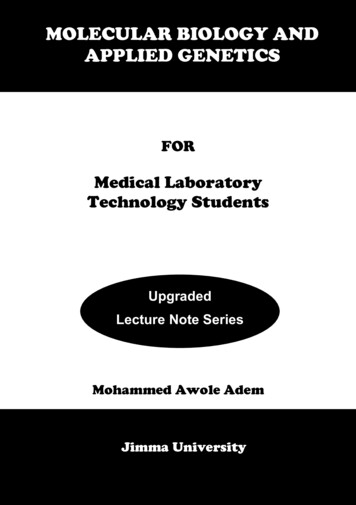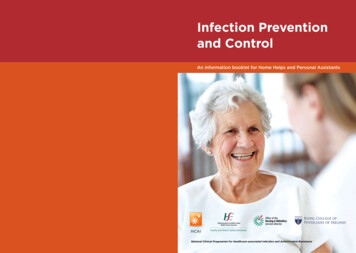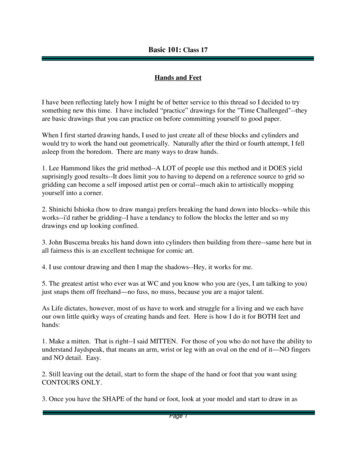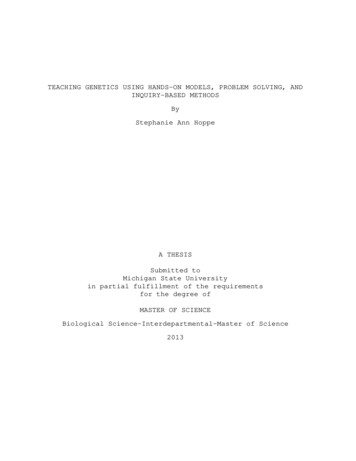
Transcription
TEACHING GENETICS USING HANDS-ON MODELS, PROBLEM SOLVING, ANDINQUIRY-BASED METHODSByStephanie Ann HoppeA THESISSubmitted toMichigan State Universityin partial fulfillment of the requirementsfor the degree ofMASTER OF SCIENCEBiological Science-Interdepartmental-Master of Science2013
ABSTRACTTEACHING GENETICS USING HANDS-ON MODELS, PROBLEM SOLVING, ANDINQUIRY-BASED METHODSByStephanie Ann HoppeTeaching genetics can be challenging because of thedifficulty of the content and misconceptions students mighthold.This thesis focused on using hands-on model activities,problem solving, and inquiry-based teaching/learning methods inorder to increase student understanding in an introductorybiology class in the area of genetics.Various activitiesusing these three methods were implemented into the classes toaddress any misconceptions and increase student learning of thedifficult concepts.The activities that were implemented were shown to besuccessful based on pre-post assessment score comparison.Thestudents were assessed on the subjects of inheritance patterns,meiosis, and protein synthesis and demonstrated growth in allof the areas.It was found that hands-on models, problemsolving, and inquiry-based activities were more successful inlearning concepts in genetics and the students were moreengaged than tradition styles of lecture.
ACKNOWLEDGMENTSI would like to show my gratitude for the teaching staffat Michigan State University for the support they have given methroughout the program.I would especially like to thank myamazing professors, Drs. Merle Heidemann, Chuck Elzinga, andKen Nadler, for their knowledge and guidance through theprocess.A special thanks to Dr. Merle Heidemann, for being aninspiration and a role model throughout my undergraduate years,and last thirteen years of my teaching career.I am going tomiss her very much.I would also like to thank my husband, Doug, and children,Taylor, Zach, and Michael, for their love and support during mymasters program.I am very proud to finish the program whilehaving three children during the courses.I hope to become aninspiration for them to achieve a higher level of educationduring their lives and make education a priority.I would nothave been able to finish the program without the support of mywonderful husband.I would like to thank him for watching ourchildren and understanding of how important this was to me.Iwould also like to thank my parents for instilling in me a loveof science at a young age.iii
TABLE OF CONTENTSLIST OF TABLES.vLIST OF FIGURES.viINTRODUCTION.1Theoretical Framework for Teaching Genetics.2The Science behind ion of Activities.19Fast Plant Investigation (Appendix III A) GuidedInquiry Activity.19Sponge Bob Genetics(Trimpe, 2003)Problem SolvingActivity.20SeaWorld Dihybrid Cross Activity(Busch Gardens,2003)Problem Solving Activity.20Pool Noodle Chromosomes modeling Meiosis (AppendixIII B) Hands-on Model Activity.21Meiosis Models (Appendix III B) Hands-on ModelActivity.22Protein Synthesis Models (Appendix III C) Hands-onModel Activity.22"Super" Clam Activity (Appendix III D) Hands-on ModelActivity.23Sponge Bob Incomplete Dominance Activity (Trimpe,2003)Problem Solving Activity.24Blood Typing Murder Mystery (Appendix III E)ProblemSolving ENDIX I: Parent Consent Form and State Objectives.44Appendix I A: Parental Consent Form.45Appendix I B: Michigan High SchoolContent/Objectives concerning genetics taken from theMichigan Department of Education Website.49iv
APPENDIX II: Pre/Post-Tests, Rubric, and RubricExplanations.52Appendix II A: Pre/Post-test.53Appendix II B: Pre/Post-test Assessment Rubric.56Appendix II C: Thorough explanation of rubricscores.58APPENDIX III: Activities and Labs.62Appendix III A: Fast Plant Guided Inquiry Lab.63Appendix III B: Meiosis Models Activity.65Appendix III C: Protein Synthesis Models Activity.70Appendix III D: "Super" clam case study activity.74Appendix III E: Blood Typing Murder Mystery.76Appendix III F: Polygenetic Inheritance Activity.78BIBLIOGRAPHY.81v
LIST OF TABLESTable 1: Sequence of Activities and Objectives. This tableincludes all activities and objectives addressed during thegenetics unit and their category as a hands-on model, problemsolving, or Inquiry based activity. See Appendix I B forobjective descriptions. .17Table 2: Mean scores of the pre/post-tests, t-values andstatistical significance for the genetics unitassessment.29Table 3: Genetics Unit Assessment Rubric.57vi
LIST OF FIGURESFigure 1: Comparison of the Mean Pre/Post-tests scores perQuestion. For interpretation of the references to color inthis and all other figures, the reader is referred to theelectronic version of thisthesis.26Figure 2: Distribution of the number of students with eachscore per question on the pre-test. Number of students tested(N) equals sixty-seven. The scores per question ranged from aminimum of zero to a maximum of three points. The blue columnindicates the number of scores of zero, the red columnindicates the number of scores of one, the green columnindicates the number of scores of two, and the purple columnindicates the number of scores of three.27Figure 3: Distribution of the number of students with eachscore per question on the post-test. Number of students tested(N) equals sixty-seven. The scores per question can range froma minimum of zero to a maximum of three points. The bluecolumn indicates the number of scores of zero, the red columnindicates the number of scores of one, the green columnindicates the number of scores of two, and the purple columnindicates the number of scores of three.28vii
INTRODUCTIONThe world of biology contains many difficult concepts tounderstand, genetics being one of many.When deciding whatunit to use for this study, complex topics were considered suchas photosynthesis, cellular respiration, and enzyme function,but the unit of genetics and heredity was the selection.Oneof the reasons it was chosen was due to the disengagement ofprevious students with the topics of inheritance patterns,meiosis, Deoxyribonucleic acid or DNA, and protein synthesis,so the focus was set on these areas.The students have askedfor more active learning activities and less lecture duringthis unit.Also, the world of education is ever changing, andwith more emphasis being place on standardized test scores,this topic was chosen because it was the area where thestudents have exhibited lower scores in comparison to othertopics in biology, according to the Michigan Merit Exam and theclassroom assessments.What the previous genetics unit lacked was engaging,active, and inquiry based activities.Previously, lecture withnote taking, paper models, and genetics problems using peaplants as examples were used, but they did not seem to excitethe students.Their lack of engagement showed as increase incomplaints about the subject matter, and poor scores ininformal and formal assessments.The hypothesis on which this1
study is based is that the use of hands-on models, problemsolving, and inquiry based teaching/learning methods willincrease student engagement and achievement in genetics.Theoretical Framework for Teaching GeneticsStudents commonly carry misconceptions into their biologyclasses including those related to topics of genetics. Themajority of the unit studied focused on meiosis and proteinsynthesis, very difficult concepts for students to understand.There are many examples of misconceptions or incompleteinformation students have concerning meiosis because it is verysimilar to mitosis, their complex relationship confusesstudents and makes it difficult for them to grasp theprocess(Harrell, 2001).Other concepts that confuse studentsregarding meiosis include: the structure of homologouschromosomes consisting of sister chromatids that carry the sameallele and chromosome behavior during meiosis(Knippels, Waarlo,and Boersma, 2005).An understanding of the mechanism of DNAand genetics is essential to a thorough education inbiology(Roberg, 2004).The students have difficulty with understanding the flowof genetic information from DNA to protein.This is partiallydue to the fact that students cannot see the actual molecules2
involved and the process itself with their eyes (Guzman andBartlett, 2012).In order to undo a misconception, students need to be ableto support a valid scientific concept with evidence thatcontradicts the misconception(Lawson and Thompson, 1988). Thegoal of this project is remove all misconceptions and toconnect all of these concepts in a complete fashion that is notabove the student's heads; and to bring them to a level ofgeneral understanding of inheritance patterns, DNA structure,making proteins, and gametogenesis.A complete understandingof difficult topics in genetics can be achieved through usinghands-on methods, problem solving, and inquiry based methods.The three approaches of teaching/learning methods ofhands-on models, problem solving, and inquiry are allinterconnected and work together as a lattice in many ways.The problem-solving approach to science instruction has thepotential to engage students in authentic investigations anddevelop their inquiry skills(Chiapetta, 1997). Teaching scienceas inquiry stresses active learning and the importance ofunderstanding a science topic(ibid.). Both of the previousstatements, show how the relationship among the use of activelearning techniques and problem solving strategies areinherently used as methods to teach inquiry-based science.3
Each method has extensive research behind it that have shown tobe successful in the classroom.Many methods have been used to teach chromosomalrelationships and movement during meiosis. Some have beensuccessful while others have not.One technique that falteredwas using computer animations to show the processes of meiosisand protein synthesis.It failed due to the fact that it was apassive process(Locke and MerDermid, 2005).be taught through an active/tactile process.Meiosis needs toExtensiveeducational research has demonstrated that student learningimproves when students are actively engaged(Guzman andBartlett, 2012).The expectation is that comprehension increases whenstudents can visualize the process and actively move chromosomemodels through the process of meiosis in a kinesthetic way withtheir hands(Barnhart and Farrar, 2011).Also, students usingtheir hands to construct a model are likely to have their mindsengaged and become intimately familiar with the vocabulary ofmolecular biology(Malacinski and Zell, 1996).Both of theseresearch groups, have confirmed that using hand-on chromosomalmodels leads to a greater understanding of meiosis compared toother methods.4
Another learning strategy that can be incorporated throughusing hands-on models is diagramming the process.The phasesof meiosis can be illustrated as the students manipulate themodels through the stages of meiosis.Students thatgraphically represent the relationships between chromosomes,genes, and alleles clarify how the concepts are related(Banetand Ayuso, 2000).A level of student understanding of meiosiswas demonstrated by the students drawing the chromosomes andalleles during the phases.Hand-on models can be manipulated by the studentsindividually or in small groups.Large scale models can evenbe used in groups as large as the class itself.It was foundthat going through the process of meiosis as a class, mayincrease both knowledge and recall(Marzano, Pickering, andPollock 2001).In addition, a basic understanding of genetics andheredity involves problem solving.Problem solving isessential to student achievement because it requires a deeperunderstanding of the material(White, Bolker, Koolar, Ma, Maw,and Yu, 2007).The nature of problem solving consists of fourstages: problem identification, solution generation, solutionevaluation, and solution execution(Friedel, Irani, Rhoades,Fuhrmann, and Gallo, 2008)5
Also, it has been found that students construct theirunderstanding by solving real world problems(Crawford, 2000).It is imperative in teaching genetics to use problem solvingstrategies to deepen understanding, and the students willretain more knowledge by constructing their own framework ofhow traits are inherited.The problems also need to berelevant to the students lives in order to improve retention.Practice and repetition have to be incorporated intoproblem solving methods in order for them to be effectivelearning techniques.It requires considerable knowledge andpractice through solving many similar genetics problems tobecome successful at this kind of problem solving(Smith andGood, 1984).As in mathematics, students would not learn aprocess by solving one problem.solving many problems.genetics.Learning takes place throughThe same is true in the field ofWhen developing problem solving strategies ingenetics, it is required that the students solve manyinheritance problems with frequent checks of understanding inbetween problems in order to build a solid understanding of howtraits are based down from parent to offspring.Inquiry-based methods are common teaching strategies usedin science education.The Next Generation Science Standardsare promoting science practices or inquiry in the classroom.6
It has been stated that inquiry is the "central strategy forteaching science"(Keys and Bryan, 2001).It has been foundthat very few students have a good understanding of the wayscience is completed because of their lack in experience inengaging in scientific inquiry(Campbell, Der, Wolf, Packenjam,and Adb-Hamid, 2012).An increase in the amount of inquirybased activities in the classroom, where a problem is posed andscience process skills are used to try to rationalize theproblem, is correlated with an increase in understanding ofscientific concepts such as genetics.Inquiry is used to promote activity-oriented learning thatreflects scientific investigation, specifically by usingobservation, experimentation, and reasoning as practiced byscientists(Chiappetta and Adams, 2004).To meet thisinstructional goal, labs that use basic science process skillsneed to be integrated.It is difficult to find inquiry-basedlabs in the area of genetics.However, Fast Plants orBrassica rapa have been used to teach genetics for a variety ofreasons including their short life cycle, genetic diversity,and lack of ability to self pollinate(Wendell and Pickard,2013).Guided inquiry labs can easily be completed by usingFast Plants and observing the traits in subsequentgenerations.7
It has been found that students using an inquiry basedapproach score higher on standardized assessments, improvetheir science process skills, and have more positive attitudestoward science(Gibson and Chase, 2002).In order to improvelevels of understanding and assessment scores, inquiry-basedactivities are a must.It has been found that many types ofactivities promote inquiry in the classroom.Guided inquirylab experiments, hand-on models, and problem solving areincluded in these type of activities.These types ofactivities have resulted in an improvement in studentachievement and learning by many educators.The Science behind GeneticsMeiosis is the process by which chromosomes divide to formgametes or sex cells.Meiosis is much different from mitosisyet similar at the same time.The process is different frommitosis because four cells are produced instead of two and theyare genetically different.genetically different.There are two reasons why they areOne reason is because they cells dividetwice, completely separating all the gene pairs in the cells.The cells originate as diploid(2N)and result into fourhaploid(1N) cells at the end of both divisions, where N is thenumber of chromosomes in an organism.For example, ifperson was heterozygous for a characteristic, two of the8a
gametes produced through meiosis would have the dominant traitwhile the other two would have the recessive.The possiblecombinations of chromosomes in a human gamete is 2N, where Nequals 23.That means that 223 equals over eight millionpossible combination of chromosomes in an egg or sperm.Also,the chromosomes cross over and exchange pieces of chromosomeduring meiosis.In this process, the homologous chromosomesbecome tangled as they cross over; when they split apart, whatwas once the paternal chromosome has a part of the maternalattached and the maternal chromosome has part of the paternalattached.A monk named, Gregor Mendel, is the father of moderngenetics and heredity.In the 1800's, he used pea pods tostudy heredity(Campbell, 2002).He looked at characteristicslike plant size and pea color, which we now call phenotypes andconducted test crosses to observe what the characteristics ofthe offspring would be in the next generation.The two plantsthat are crossed are called the parent generation and the firstgeneration offspring was call the F1 generation.What he sawwas that there was one trait that showed up more than theother.yellow.For example, there were more green colored peas thanHe called this the principle of dominance.9
Also, he concluded that parents contain two alleles for atrait and they only pass on one of the two alleles to theiroffspring.This law he called the law of segregation, the twoalleles segregate from one another during gamete(egg orsperm)formation which is based on meiosis.An allele is a formof a trait and for a single gene characteristic it can beeither dominant or recessive.Characteristics also have genotypes.The genotypeconsists of the two alleles that are inherited by offspring fora discrete characteristic.Since two parents can haveoffspring with different phenotypes or physicalcharacteristics, it means that in this case the parents eachhad a hidden allele called the recessive allele in theirgenotype for that characteristic.Also, the parent genotypesmust be heterozygous or carriers where they have a dominant andrecessive allele for the gene and show the dominant phenotype.This is considered the norm.Mendel also concluded that characteristics on differentchromosome pairs are inherited independent of one another.When gametes form, one allele for each characteristic is passedto the daughters cells.When a parent produces a gamete thechromosomes containing the genes independently assort from oneanother, so each gamete only contains one chromosome of a10
homologous pair instead of two.The cell division that occursto produce gametes is called meiosis.There are instances where alleles interact in ways toproduce proteins, whose patterns differ from typical dominantand recessive inheritance patterns.These allele combinationscan result in more than two phenotypes.Co-dominance is anexample of inheritance that differs from the norm.Co-dominance is when two alleles are dominant for a trait and areexpressed in such a way that the combination of two alleles isdifferent than either homozygote.An example is blood type.When a person inherits alleles for A and B blood the person hasAB blood instead of one dominating over the other.A and B are co-dominant.The allelesBlood typing is also interestingbecause it is an example of multiple alleles.There are threepossible alleles that determine blood type instead of two,although humans still inherit two.Multiple alleles allows formore than two phenotypes and three genotypes to be inherited.Incomplete dominance is different than normal dominantrecessive inheritance because there are only two alleles for atrait but neither is dominant.When the two traits areinherited together they blend into a new phenotypes.Forexample, incomplete dominance is shown by crossing red flowersand white flowers to produce pink flowers.11Some
characteristics are polygenetic where there are many genes thatdetermine the phenotype for that characteristic.Examples ofpolygenetic characteristics are hair, eye, and skin color.Humans carry more than one gene for these traits and theblending of allele products results in multiple phenotypes.In 1953, it was found that DNA's chemical structureactually looks like a double helix by Watson andCrick(Campbell, 2002).The sides to the DNA helix arerepeating phosphate and sugar chain, but the rungs are made ofnitrogen base pairs.Adenine always binds with Thymine makingtwo hydrogen bonds and Cytosine always binds with Guaninemaking three hydrogen bonds.The difference between the numberof bonds is why adenine does not make a chemical bond tocytosine.Every human being has a different sequence of baseson their DNA.The 3 billion bases for the human genomecontains around 25,000 genes(Roberg, 2004). All human Genomesare 99.9% the same, but that 0.1% accounts for all of ourdifferences(Miller and Levine, 2004).The sequence of nucleotides of DNA contains theinformation necessary to make the building blocks of our bodywhich are proteins.A DNA molecule is too big to fit out ofthe nuclear pores to get to the ribosomes to make the protein.Instead, DNA is transcribed into messenger RNA using an enzyme12
called RNA polymerase.Ribonucleic Acid or RNA is singlestranded and contains the nitrogen base uracil instead ofthymine as in the case in DNA.The messenger ribonucleic acidor mRNA strand, when complete, travels into the cytoplasm to aribosome.The ribosome "reads" the mRNA sequence by connectingtransfer ribonucleic acid or tRNA molecules with an amino acidattached to them.Every three bases on the mRNA strand iscalled the codon.The codon binds to three complementary baseson the tRNA called the anticodon.The codon on the mRNA andanticodon on the tRNA specify a particular amino acid.Theamino acids brought to the ribosome link together using peptidebonds until the protein chain in complete.Once the proteinchain is complete it can be used by the cell or sent to otherparts of the body.Occasionally, a change in the DNA sequencewill occur which is called a mutation.The mutation can changethe protein by altering which amino acid is in the proteinsequence.DemographicsThis study occurred at Grass Lake High School.Thevillage of Grass Lake is located between Ann Arbor and Jacksonon I-94.It has a population of 1,173 people.It is a farmingbased community, but urban sprawl and new subdivisions havechanged the demographics of the area in recent years.13People
commute to Jackson, Ann Arbor, Detroit, and Lansing from GrassLake.There are 404 students at the high school, which is96.3% Caucasian, 1.7% Hispanic, 0.7% Native American, 0.5%African American, and 0.5% Asian(usaschoolinfo, 2013).year, 84 studentsLastqualified for free and reduced lunch(iteach,2013). The factor that separates students is socioeconomicclass.Many students have families that have lived in the areafor many years and own family businesses and farms.There aresome families from the Ann Arbor area that are looking for moreaffordable housing.Grass Lake High School accommodates arange of students from those who live on public assistance tostudents whose parents have doctoral degrees.Grass Lake district's goal is be able to competeacademically at the level of our neighboring school district inChelsea, Mi.Last year, Grass Lake High School student's ACTscores were amongst the highest in the county.The expectationis that the students that graduate from Grass Lake will beready for a university education.Three introductory biology classes were used for thisresearch project.These classes consisted of two ninety minutesemester long block classes and one fifty-five minute classthat ran the entire year.Seventy consent forms were14
submitted, providing permission to use their classroom data.Out of those seventy students only one had special needs.15
IMPLEMENTATIONIn preparation of this study, six weeks were spent duringthe summer of 2012, researching different strategies andactivities expected to be successful in teaching the themeswithin the unit of genetics.Activities that used inquiry,hands-on models, and problem solving were targeted forinclusion in this unit.Many hours were dedicated to buildingnew activities/models, and other activities that other teachershave used were adapted.On the first day of school the students were given theparental consent forms(Appendix I) and informed that theinstructor was conducting research this year in her classes inorder to write a thesis the following summer.The consentforms were not accessed the entire year until the grades werecompleted.The new genetics unit started after we coveredcells, cell division, and mitosis.The unit began with a pre-test assessment to gather information of the students priorknowledge as the main objective.The pre and post-tests(Appendix II A) were identical and consisted of twelveopen ended questions that were scored according to arubric(Appendix II B).The scores awarded ranged from 0through 3 points for each question.A score of 0 indicatedthat the student did not complete the question or their answershowed a misconception.A score of 1 indicated that the16
student showed a basic understanding of the question.A scoreof 2 indicated that the student showed a developingunderstanding beyond the basic.A score of 3 indicated thatthe student showed a mastery of the concept with a completeanswer that included all of the relevant information.Thesequence of activities that were implemented into this unitafter the pre-test are shown in Table 1.Also included in thistable as a curricular guide throughout the unit are theMichigan objectives and an indicator if the activity usedhands-on models, problem solving, and inquiry.Table 1: Sequence of Activities and Objectives. This tableincludes all activities and objectives addressed during thegenetics unit and their category as a hands-on model, problemsolving, or Inquiry based activity. See Appendix I B forobjective descriptions.DayState ObjectivesaddressedActivityDay .1D,Pre-testDay 4.2D.B4.2G,B4.3C,B4.3F,B4.1B, B4.1C,B4.1EMendelian GeneticsUsing Sponge BobProblems and BeginBrassica/FastPlant quiry(I)PS, I
Table 1: Cont'dDay 3B4.1A, B4.1B, B4.1C,B4.1D, B4.1EDay 4B4.1A, B4.1B, B4.1C,B4.1D, B4.1EDay 5B4.3A, B4.3B, B4.3C,B4.3D, B4.3E, B4.3F,B4.3GDay 2A,B4.2D.B4.2GB4.1A,B4.1D,B4.3B, B4.3C,B4.3E, 1B,B4.1E,B4.2C,B4.2F,B4.3B,B4.3E,Day 7Day 8Day 9Day10Day11Mendelian GeneticsUsing Sponge BobPart 2SeaWorld Dihybridcross activityTake Data andwriting Resultsand Conclusionsfor Fast Plant LabMeiosis Activitywith Pool NoodlesMeiosis ModelActivityMeiosis ActivityPart 2PSIMMB4.2B, B4.2C,B4.2EB4.2B, B4.2C,B4.2E, B4.2F,Superclam ActivityPSProtein SynthesisModelsMB4.2B, B4.2C,B4.2E, B4.2F,Protein SynthesisModels Part 2MB4.1B, B4.1C,B4.1ESponge BobIncompleteDominance ActivityBlood TypingMurder B4.3C,B4.3F,18
Description of ActivitiesFast Plant Investigation (Appendix III A)Guided InquiryActivityIn this activity, the students observed mendelian geneticconcepts by studying Fast Plants .Thecharacteristic/phenotype they observed was stem color.Thisexperiment was organized using a guided inquiry format wherestudents were to make predictions/hypotheses about which stemcolor was the dominant or recessive trait, and determine theoutcomes of the parental cross and f1 crosses.were separated into three groups.The studentsOne group of studentsgerminated the parental generation, the second group germinatedthe F1 generation, and the third group germinated the F2generation.Once the seeds sprouted over the course of threedays, the students collected the qualitative data of stem colorfor the three generations and compiled it as a class.Afterthe data collection was completed the students continued withthe discussion and conclusions, where it was determined thatpurple stem color was dominant over green stem color.Theexpected phenotypic ratios of the offspring for the F1 and F2generation were calculated using punnett squares and comparedto the actual data collected.19
Sponge Bob Genetics(Trimpe, 2003)Problem Solving ActivityIn this unit, problem solving activities were implemented thatused a familiar test subject, "Sponge Bob".The conceptsaddressed in this activity were dominant and recessive alleles,homozygous and heterozygous pairs; and test crosses/punnettsquares were conducted to determine expected outcomes.Thestudents conducted the Sponge Bob crosses and calculate thegenotypic and phenotypic ratio and percentages of offspringwith certain alleles.The students were given differentscenarios using Sponge Bob and his friends a
hands-on methods, problem solving, and inquiry based methods. The three approaches of teaching/learning methods of hands-on models, problem solving, and inquiry are all interconnected and work together as a lattice in many ways. The problem-solving approach to science instruction has the pot
